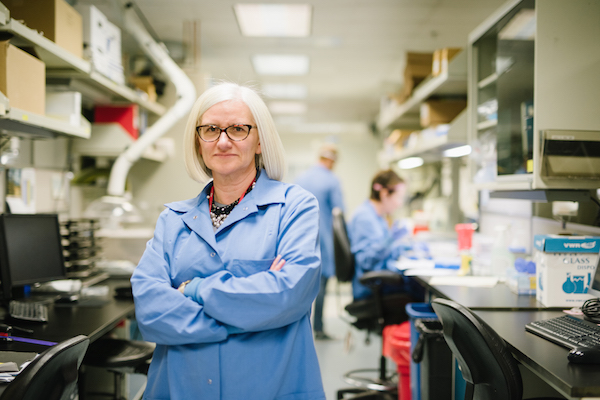
Author: Peta Owens-Liston

“She smiled a lot, crawled at a year, walked at 18 months—this was slow but not alarming. It wasn’t enough to make a pediatrician seek out testing,” recalls Heidi Wallis about her oldest child, Samantha (affectionately known as Sam). At two, she “had no words.” “I kept saying to myself, ‘she is going to be fine. She is just moving at her own pace.’ Everyone else said not to worry, that I was just being a nervous first-time mom.”
But things didn’t get better. Sam became increasingly more delayed. Wallis spent the first five years of her daughter’s life desperately trying to figure out why Sam was struggling and what would help.
When she was five years old, a DNA test finally pinpointed the cause of Sam's troubles. She has a mutation in the GAMT (guanidinoacetate methyltransferase) gene. The broken process means that she has very little creatine, an essential nutrient that provides energy to cells. This disorder was only discovered in 1994, nine years before Sam’s arrival on a hot July morning. The disorder is rare; at the moment, Sam is only one of about 110 people worldwide with a documented diagnosis of GAMT deficiency.
What if Sam had been treated since birth?
When Sam’s tests came back, her care team turned to University of Utah Health pedric geneticist Nicola Longo, MD, PhD, a soft-spoken, Italian-born physician well known for his research and expertise in caring for patients with GAMT deficiency. At his Primary Children's Hospital-based clinic, he guides the care of six patients in Utah and a dozen nationally.
University of Utah Health pedric geneticist Nicola Longo, MD, PhD, a soft-spoken, Italian-born physician well known for his research and expertise in caring for patients with GAMT deficiency. At his Primary Children's Hospital-based clinic, he guides the care of six patients in Utah and a dozen nationally.
While the effects of a creatine metabolism disorder are severe, the “cure” is relatively simple and inexpensive: a mix of several supplements. Longo fine-tuned the treatment by monitoring his patients’ progress over the years. In addition to replacing the missing creatine, he added ornithine and sodium benzoate to prevent the buildup of toxins in the brain that cause seizures. “We measured and monitored everything biochemically and adjusted it until we saw clinically it was making a difference.”
Almost immediately after Sam started the treatment, her speech improved. “Ba, ma, da” became “ball, mommy, duck.” Within nine months, she was stringing together five or six words at a time, excitedly sharing what she wanted to eat, where she wanted to go. “She was so excited to finally be heard and understood,” says Wallis.
What if Sam’s treatment had started as a newborn instead of at five years old? She would likely be navigating middle school like any other 13-year-old girl. Wallis knows, because her son, Louis, born eight years after Sam, was tested for the disorder as a newborn. He tested positive and was started on the supplements immediately.
Today, Louis is a rambunctious preschooler with no signs of slowing down. “I’ll never stop watching him super close looking for any hints or signs of delays,” confides Wallis. “He’s going to grow up like other kids, whereas Sam will need me for the rest of her life.”
"Right now, diagnosis is 100 percent luck"
One day in 2008, Longo went home and shared with his wife that he had seen his first patient with GAMT deficiency in clinic and f elt there was something more that could be done to prevent other children with the disorder from receiving the treatment they need.
elt there was something more that could be done to prevent other children with the disorder from receiving the treatment they need.
The conversation may have ended there, but the topic hit close to home. His wife, U of U pathology professor Marzia Pasquali, PhD, was instrumental in developing the newborn testing program in Utah and is the head of the Biochemical Genetics and Newborn Screening section at ARUP Laboratories, a nonprofit enterprise owned by the University of Utah.
Routine newborn screening panels carried out in Australia and British Columbia test for GAMT deficiency. Pasquali immediately saw a way that she could modify an existing test to seemlessly integrate with Utah's newborn screening panel.
Within two years, Pasquali developed a new method to screen for GAMT deficiency, and it worked spectacularly, picking out three known GAMT deficiency samples from 10,000 archived newborn bloodspots, with no false positives. Working with the Utah Department of Health, the test was added to Utah’s newborn screening panel in 2015—the first state to offer it.
Pasquali estimaes that 1 in 120,000 have the disorder, and with more than 50,000 births a year in Utah, it is just a matter of time before the test finds a child born with a creatine deficiency. But in the 49 other states that do not have a GAMT test folded into their newborn panel, kids with the disorder are highlly likely to fall through the cracks.
“Diagnosis for a GAMT kid is 100 percent luck right now. A full life or a life of misery is currently left to chance. And it just doesn't have to happen,” says Wallis. She accepts that there was no testing available when Sam was born; she cannot accept the fact that there are children being born today whose families will end up living out the same diagnostic odyssey that theirs did.
Wallis has pulled in help from Longo and Pasquali to lobby for implementation of GAMT deficiency screening nationally. Longo also serves on the medical advisory board for the Association for Creatine Deficiencies of which Wallis is a boardmember. When Pasquali and Longo started their careers, they never imagined that they would be flying to Washington D.C. to advocate for their patients. But now they can't imagine doing anything differently.
 “We’ve always tried to do the best we can for families but now we’re taking it to a different level,” says Pasquali. “We have the chance to give these kids a normal life. It’s a terrible waste to do nothing.”
“We’ve always tried to do the best we can for families but now we’re taking it to a different level,” says Pasquali. “We have the chance to give these kids a normal life. It’s a terrible waste to do nothing.”
- modified from an original story published in Magnify, an ARUP Laboratories magazine